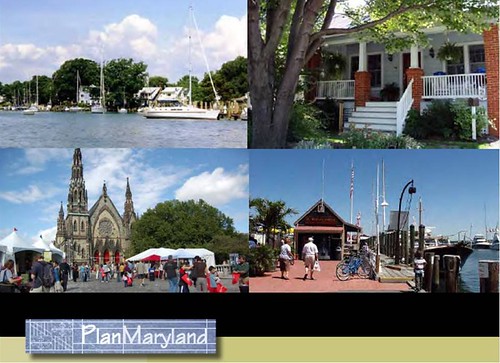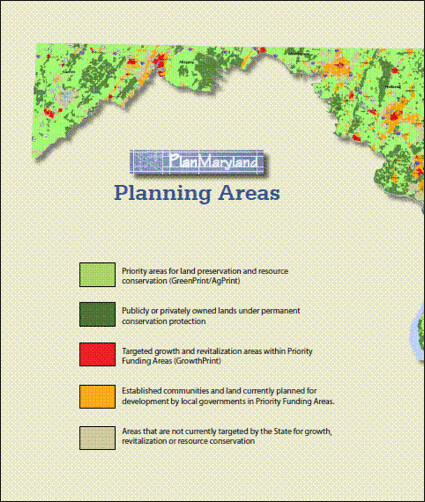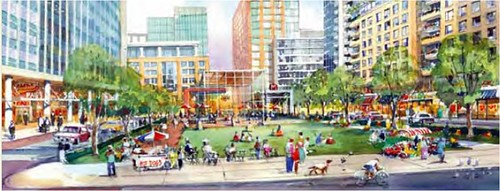Maryland gives smart growth another push

Posted September 7, 2011 at 1:26PM
I’m of the opinion that the package of (bold, at the time) smart growth policies introduced in Maryland in the 1990s by then-governor Parris Glendening has done a great deal of good, particularly in encouraging revitalization of city and town centers and conservation of rural lands. No, the smart growth laws have certainly not put an end to sprawl, which I’m sure is as or more disappointing to Glendening than to anyone.
But, with the benefit of hindsight, that was way too much to expect. To reduce state subsidies for infrastructure construction outside of locally designated growth areas was a big step for the 1990s, as was putting several policies together in one package, from highway spending to brownfields reclamation, from live-near-your-work incentives to affordable housing and rural land protections. It’s not for nothing that Glendening is still regarded as one of the country’s foremost leaders on these issues, even if the legislative compromises necessary to pass the laws set density targets too low and failed to provide enough oversight to prevent all sorts of abuses of local discretion.
But it is no longer the 1990s, and it is time in Maryland as elsewhere to take additional steps. Governor Martin O’Malley and planning Secretary Richard Hall realize that, and as a result have been moving forward with an ambitious statewide planning process. A draft of PlanMaryland was published for comment in April and an updated version is to be released this week for another comment period. I haven’t read the new draft, but I’m expecting it to continue (as it should, in my opinion) a number of key aspects from the initial draft:
- Designation of tighter areas for planned growth will be a shared responsibility between state and local governments.
- There will be more integration among currently separate policies and programs at both levels of government. As the April plan’s executive summary puts it, “rural resource lands cannot be sufficiently protected from development through the State’s preservation programs unless local zoning and related tools limit adjacent development consistent with the programs’ objectives. Similarly, greenhouse gas emissions from mobile sources cannot be effectively controlled if the majority of the workforce can reach their jobs only by driving from homes so widely dispersed that they cannot be served by public transportation.”
- The state will establish a “PlanMaryland Consistency Process” to ensure that both local and state actions support the goals of the plan and that state policy and spending contribute effectively to the achievement of plan goals.
In other words, PlanMaryland, if it proceeds to adoption, will begin to put some teeth into the existing smart growth policies now largely controlled by the municipalities. About time, I say.
As you might imagine, local government officials are extremely antsy about the whole thing. According to a story written by Aaron C. Davis for The Washington Post, the complaints are coming fast and thick that the state is moving too quickly and that the plan would have “the effect of taking land use decisions out of the domains of elected officials who are accountable to the people and putting them in the hands of [state] agencies who are not accountable to the people,” according to one county commissioner.
Too quickly? Really? Maryland’s smart growth laws have been on the books for 14 years. This particular planning process, which includes a full six months of official commenting, has already involved discussions with “more than 50 stakeholder organizations and feedback from more than 2,000 people representing a diverse cross-section from throughout Maryland.” That doesn’t sound like a fast track to me.
Meanwhile, it’s not exactly like the locals can show that the old ways have been working. From the executive summary:
“Since the 1997 law sought to encourage development in areas best equipped for it, more than three-quarters of residential growth in land area in Maryland has occurred outside those areas.”
In actuality, it’s past time to try new, more aggressive measures. As the summary puts it:
“These [sprawling] trends are compounded by a rapidly expanding and aging population, sea level rise and other threats from climate change, global economic realities and the challenges of a post-petroleum era that is just beginning. The State is projected to grow nearly 15 percent over the next 20 years with an additional 900,000 people. These forces require of us a new approach to how we use our limited land and resources in the future.
“It is virtually impossible for the State and local governments and the private sector to address these intertwined challenges without first embracing a unifying comprehensive strategy. It must set in motion procedures to establish how and where the State will develop, determine the resources it must protect and how, and set proactive roles that the State and local governments and the private sector must play during the 21st century to make it possible. PlanMaryland is a blueprint for such a strategy.”
I would like nothing better than for Maryland’s local governments to be able to show that they have been great at curtailing sprawl and protecting the state’s environment. But that’s just wishful thinking: in fact, history shows just the opposite, and it’s time to try something new. Everyone with a stake should have a voice in how to comply, but there needs to be much better oversight to ensure that the goals of policy are realized. That’s the role of the state.
Move your cursor over the images for credit information.




